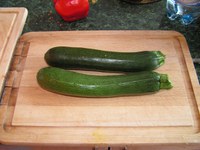Prairie Fare: Zucchini Has Many Roles on the Menu
(Click the image below to view a high-resolution image that can be downloaded)
By Julie Garden-Robinson, Food and Nutrition Specialist
NDSU Extension Service
“I’ve been reading your column for a long time, and I’m wondering about zucchini. I know you can use it for bread, but what else can you do with it? Is it healthy?” the gentleman asked on my answering machine.
I chuckled when I listened to his message. I was wondering if someone had left a pile of zucchini on his doorstep or on his car seat when he wasn’t looking.
Zucchini are notoriously prolific producers in gardens. If you don’t find them early enough under their foliage, they can grow to be 3 feet long.
I called him back and reached his answering machine. Then he left me a message while I was at a meeting. He was wondering if I could write something about zucchini. If my faithful reader picks up the paper or reads this online, here is the column inspired by the call.
If you have some zucchini or other squash, you are enjoying the modern version of a food that has been around a long time. Some types of squash seeds have been found in archeological digs dating back thousands of years. Zucchini, according to some sources, wasn’t used in its more modern form until the 1800s, and many people trace its origins to Milan, Italy.
Zucchini gets its name from the Italian word “zucca,” which means squash. Although botanically a fruit, zucchini is used as a vegetable on the menu.
Zucchini is a variety of summer squash and can be green or yellow. Zucchini is low in calories and a good source of vitamin C, with no fat or sodium unless you add it.
It is not as nutrient-rich as its winter squash cousins with their dark orange flesh. The natural orange pigments, or carotenoids, in winter squash are converted to vitamin A by our body. Vitamin A helps keep our skin and membranes healthy.
When choosing zucchini, look for young, tender squash with shiny rinds. Avoid zucchini with bruised or dull rinds. Zucchini can be added to breads, muffins, soups and casseroles. It can be stuffed with fillings to serve as a main dish or served raw as an appetizer. Zucchini blossoms are edible and can be stuffed or lightly battered and deep-fried for a novel menu item.
If you have a “carload” of zucchini, you can preserve some of it by freezing. Simply rinse it under cool, running water and cut it into 1/2-inch slices. Then blanch the slices in boiling water for three minutes. Cool it promptly in ice water and then drain and package in freezer bags or containers labeled with the contents, amount and date you froze it.
You can grate zucchini and freeze it for use in breads without blanching it. Although flavor changes can occur if you do not blanch vegetables, the spices used in breads and muffins will mask the changes.
Be a little adventuresome by making zucchini chips. You can make dehydrated zucchini chips by washing, trimming and cutting zucchini into 1/4-inch slices. If desired, sprinkle with garlic or onion powder or your favorite seasoning prior to drying. Then dry the chips in an oven or dehydrator set at 140 F until they are brittle. The chips can be stored in a plastic bag and used in soups or casseroles.
Here’s a tasty recipe adapted from the Iowa State University Extension and Outreach program. The colorful vegetables remind us of the changing colors associated with autumn.
Cheesy Pasta with End-of-the-summer Veggies
4 c. sliced or chopped, assorted vegetables (zucchini, broccoli, carrots and red pepper)
1 c. tomatoes, chopped
8 ounces pasta (rotini, bow tie, penne)
1 1/2 Tbsp. olive or canola oil
2 medium garlic cloves, minced
1/2 c. onion, chopped
1 tsp. Italian seasoning
1/4 tsp. salt
1/8 tsp. black pepper
1/4 c. Parmesan cheese
1/2 c. shredded mozzarella cheese
Rinse and prepare vegetables. Cook pasta according to package directions. Drain water and save 1/4 cup of the cooking water. Heat oil in a large skillet as the pasta cooks. Add garlic and onion to the skillet. Sauté over medium heat for about one to two minutes or until soft. Add vegetables and cook for about three minutes. Add Italian seasoning, salt and pepper. Add tomatoes last and cook until heated thoroughly. Add cooked, drained pasta to the vegetables. Add a little of the water from the pasta if needed. Add cheese to mixture and stir until the cheese is mostly melted.
Makes six servings, about 1 1/2 cups per serving. Each serving has 250 calories, 8 grams (g) of fat, 35 g of carbohydrate, 10 g of protein, 5 g of fiber and 240 milligrams of sodium.
(Julie Garden-Robinson, Ph.D., R.D., L.R.D., is a North Dakota State University Extension Service food and nutrition specialist and professor in the Department of Health, Nutrition and Exercise Sciences.)
NDSU Agriculture Communication – Oct. 3, 2013
| Source: | Julie Garden-Robinson, (701) 231-7187, julie.garden-robinson@ndsu.edu |
|---|---|
| Editor: | Rich Mattern, (701) 231-6136, richard.mattern@ndsu.edu |


